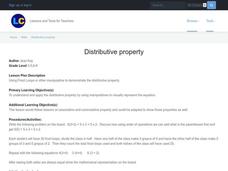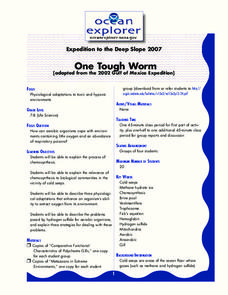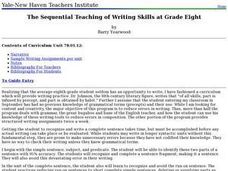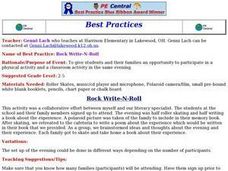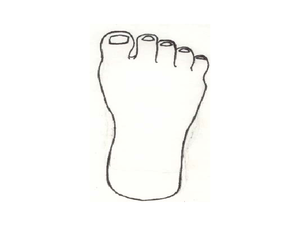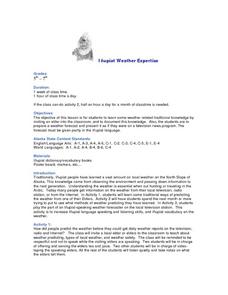Curated OER
Water Cycle Boogie
Students explore the water cycle. They learn the "Water Cycle Boogie." Students create hats to represent the different parts of the cycle and learn hand motions to go with the words of the song. Students practice singing the song and the...
Curated OER
How Big Are Earth, Sun, and Moon?
Third graders draw what they believe is in space on a dry erase board. In groups, they are given a beaker half filled with water and they add a teaspoon of oil, observing the different layers that form. To end the instructional...
Curated OER
Distributive Property
Students explore the distributive property. In this algebra lesson plan, students are given Fruit Loops or other manipulatives and the class is divided in half. Each half of the class completes part of the equation to show that both...
Curated OER
Cuisenaire Chefs
Students study the fractional values of Cuisenaire rods while working with favorite family recipes.
Curated OER
The Science of Glaciers
Students identify the contents of a glacier like those found in Patagonia. They construct a mini glacier model in class. Students compare and contrast the classroom model with Patagonian glaciers. They label specific parts of the...
Curated OER
For Goodness Sake, Power to the People
Students examine the impact of the nonprofit sector on society by researching philanthropic Websites. They role-play as minority groups that used alternative power structures to change society and write in their journals on a...
Curated OER
Geographic Regions of Arkansas
Students examine maps that illustrate the various regions in Arkansas. They label the individual regions on a blank map that is divided into the regions and color each region a different color. Groups research a region and create a...
Curated OER
What is Probability? Original Lesson Plan
Students predict, using a fraction or a ratio, the possibility of an event happening and place that fraction or ratio on a Likelihood Line. In Part Two of the instructional activity, they conduct an experiment to determine theoretical...
Curated OER
Physical Education Demonstration Program
Students demonstrate what they have learned in physical education class. In groups, they perform the different activities in front of teachers and parents. To end the lesson, they practice their creative movements and dance to specific...
Curated OER
Valentine's Themed Activities For February
Here are ways to make academics part of your Valentine's Day-related lessons.
Curated OER
Using the senses
Students use their senses to compare a frog and a hamster. In this animals comparison lesson plan, students get into groups and observe, smell, feel, and listen to what their animals are like, and classify them into categories.
Curated OER
Total English Upper Intermediate: Sequencing Events
In this sequencing events activity, students complete 6 sentence starters and write a story using one of 3 provided titles. In small groups students share their work.
Curated OER
One Tough Worm
Students explain the process of chemosynthesis and its relevance to biological communities. In this investigative activity students discuss chemosynthetic communities, then in groups they are assigned a species and are to calculate the...
Curated OER
Life Beyond the Fifty Yard Line -- An ecological look at our backyard
Students, in groups, stake out and rope off their study area, do population counts and density studies. They construct a map of the whole area, collect plants and insects, and mount and identify the organisms using keys.
Curated OER
Cool Corals
High schoolers explore corals and polyps. For this coral reef lesson students divide into groups and prepare a written report.
Curated OER
Cells in the Making
Young scholars examine and research the parts of a cell, their functions, and life processes. They simulate how cells receive nutrients using coffee filters, water, and coffee, and construct cells using pudding, cookie dough, and candy.
Curated OER
The Sequential Teaching of Writing Skills at Grade Eight
Eighth graders are introduced to the techniques to write properly. As a class, they practice writing complete sentences and discover how to avoid run-on sentences. In groups, they review action and state of being verbs and practice...
Curated OER
Rock Write-In-Roll
Students participate in physical education and classroom activities with their parents and families. To engage parent's in their student's educational process, students and family members spend part of an evening roller skating and the...
Curated OER
Biomedical Engineering: Wacky Shoes
Students create 'wacky' shoes as a part of a biomedical engineering activity. In this bioengineering lesson, students investigate old shoes cut in half and discuss the purpose of each shoe layer. Students use a shoe template to design...
Curated OER
Throwing It All Away?
Students read a New York Times article as part of their investigation as to what happens when an item is thrown away or recycled. They analyze the relationship between a product's ingredients and its effect on the Earth and healthful...
Curated OER
Environment: Inupiat Weather Expertise
Students investigate methods of weather prediction prior to modern communication sources. A local elder lectures the class on weather prediction and safety. They document the experience by creating posters. Applying methods given by the...
Smithsonian Institution
Picturing George: A Pictorial Survey of the Life of George Washington
Young scholars create pictorial biographies of George Washington. Working in groups, they research various portions of Washington's life, highlighting significant events. After presenting their projects to the class, they are displayed...
Curated OER
Cultural Diversity In The Classroom
Young scholars engage in a lesson that supports the fact that Asian people are part of the educational culture in schools. The lesson includes background information for the teacher. With the completion of the unit students develop a...
Curated OER
Scatter Cat!
First graders read the story Hairy MacLary, Scatter Cat by Lynley Dodd, to provide a context in which to use the language of movement and position and to provide opportunities to move themselves as they act out parts of the story.


